Atlantic Monthly Contributors's Blog, page 288
November 25, 2015
Frank Gifford and the NFL's Concussion Crisis
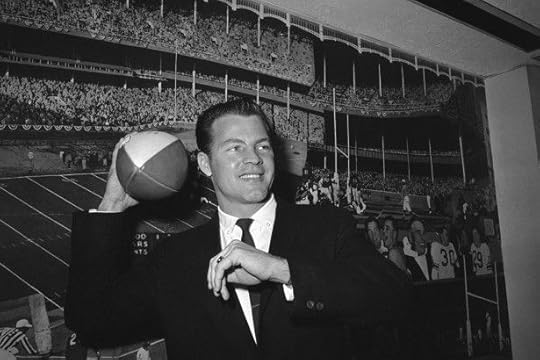
In the world of professional football, there are few names that evoke more credibility or deference than Frank Gifford.
Gifford, who died in August, was a Hall of Fame quarterback, an Emmy award-winning broadcaster, and ambassador for the sport. He won five titles, was named the league MVP, and helped form the NFL Players Association back in the 1950s. In 2008, The Atlantic put him on its short list of pro football’s founding fathers.
Gifford apparently also suffered from the degenerative brain condition CTE, which is brought on by repeated head trauma and has become most closely associated with professional football’s ongoing concussion crisis. On Wednesday, his family disclosed his condition:
During the last years of his life Frank dedicated himself to understanding the recent revelations concerning the connection between repetitive head trauma and its associated cognitive and behavioral symptoms -- which he experienced firsthand. We miss him every day, now more than ever, but find comfort in knowing that by disclosing his condition we might contribute positively to the ongoing conversation that needs to be had; that he might be an inspiration for others suffering with this disease that needs to be addressed in the present; and that we might be a small part of the solution to an urgent problem concerning anyone involved with football, at any level.
Fans of Gifford might remember that he initially retired from the sport after suffering a major head injury during a game in 1961, which sidelined him for nearly two years.
Football has never been more popular, but public interest in the concussion epidemic is only growing. Consider Concussion, the upcoming Will Smith film biopic about a medical whistleblower, which is slated for a Christmas Day release.
The negative attention is forcing the NFL’s hand as former players who suffered brain trauma behave erratically or even commit suicide and current players are walking away from the game early. Last week, former NFL players asked a Philadelphia judge to throw out a $1 billion class-action settlement with the league because it failed to address CTE.
According to a ongoing PBS Frontline project, NFL players have already suffered 108 concussions through 11 weeks of play this season. While the league has instituted new protocols, just this week they were criticized as insufficient after Case Keenum, the quarterback for the St. Louis Rams, failed to be removed from the game after suffering a concussion on Sunday.
The disclosure of Gifford’s diagnosis, particularly given his stature, will add to the NFL’s publicity woes. But it also presents the league with yet another opportunity to do more.









The 3 Arrests in Minneapolis' Black Lives Matter Shooting
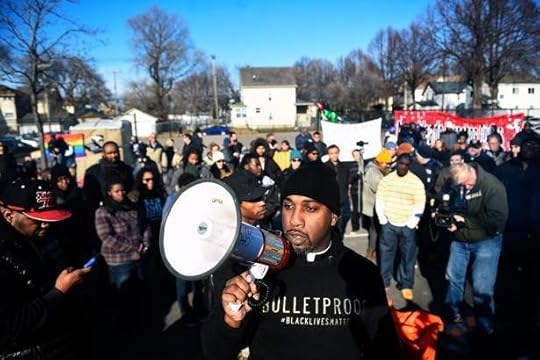
Minneapolis police have arrested three suspects in connection with the shooting of five Black Lives Matter demonstrators on Monday. The first, Allen Lawrence “Lance” Scarsella III, was caught by police. Two others, Nathan Gustavsson and Daniel Macey turned themselves in. A fourth reported suspect, a Hispanic man, was arrested but later released.
The Star Tribune reports that authorities are still debating whether to charge the men with a hate crime. The shootings took place near an encampment at the city’s Fourth Precinct police station, near where police fatally shot Jamar Clark, a 24-year-old black man, last week. Activists have been camped out demanding the release of video footage of the incident. According to activists, the men were white supremacists had been coming to the protests and trying to intimidate those who were gathered. On Monday, they arrived wearing masks and refused to remove them. When demonstrators tried to push them away, a scuffle and then the gunshots occurred.
The Star Tribune reported on what it believes to be connections between the suspects and online postings. One YouTube video shows masked men who say they’re headed to the protest site:
“We are locked and loaded,” he says, holding up a black 1911-style pistol. As he flashes the gun, he explains amid racial slurs that the men are headed to the Black Lives Matter protest outside Minneapolis’ Fourth Precinct police headquarters. Their mission, he says, is “a little reverse cultural enriching.”
“We’re gonna see if we can have ourselves a little look-see,” adds his passenger, who identifies himself as “Black Powder Ranger.”
SaigaMarine tells viewers to stay tuned. “Stay white,” he says as he signs off.
In the aftermath of the shooting, Clark’s brother Eddie Sutton called for an end to the encampment for protestors’ safety. But other activists vowed not to be intimidated, and around 1,000 people marched in downtown Minneapolis Tuesday.









The Chicago Protests Aren't Just About Laquan McDonald
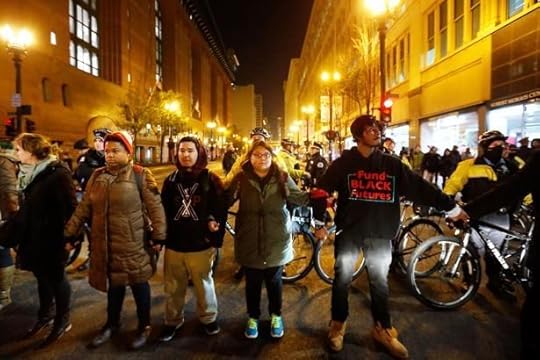
Updated on November 25 at 3:06 p.m.
Marchers took to the streets of Chicago Tuesday night, protesting the death of Laquan McDonald. McDonald, a 17-year-old black man, was shot by Officer Jason Van Dyke in October 2014, but video of his death was only released Tuesday, the same day Van Dyke was charged with first-degree murder. In general, the protests seem to have remained calm. Police said there were few scuffles and fewer arrests.
But there’s at least one notable exception: Malcolm London. The 22-year-old Chicagoan was arrested and charged with aggravated battery to a police officer, a
The Killing of Laquan McDonald
In Baltimore, Mayor Stephanie Rawlings-Blake seemed to realize the gravity of the situation after Gray’s death. While authorities are widely seen to have botched their crowd-control, they quickly appealed to calm after Gray’s death, suspended the officers involved, and promised a quick investigation. Chicago can’t claim anything like that sort of urgency. For one thing, it took 400 days for authorities to take any action more concrete than suspending Van Dyke. They fought tooth and nail against the release of the video. While Van Dyke was suspended from police duties after the shooting, his pay only stopped on Tuesday
“What happened here is wrong. There is no justification and it's profoundly hideous, in my view,” Emanuel, a Democrat, said during a short call with ministers on Monday. “And it's a shock to your conscience of what happened, and it should not have happened.” Yet the mayor himself said he had not yet watched the video, although the city approved a $5 million settlement with McDonald’s family in April.
“Jason Van Dyke violated both the standards of professionalism that come from being a police officer, but also basic moral standards that bind our community together,” Emanuel said during his press conference on Wednesday. “Jason Van Dyke will be judged in a court of law. That's exactly how it should be.”
He also spoke at length about members of the Chicago community coming together. These remarks seems to risk misunderstanding the anger sparked by the McDonald video. For one thing, Emanuel’s emphasis on shared community responsibility provoked criticism that he is passing the buck on accountability, a case that a pair of scorching Chicago Tribune columns made Wednesday. (Somewhat jarringly, Emanuel also went from a news conference about the video to the jolly occasion of a Christmas tree lighting.)
Meanwhile, the focus on Van Dyke’s actions skips over the extent to which McDonald’s death, while horrifying in its own right, has become a symbol of a much longer and broader critique of the Chicago Police Department. “Jason Van Dyke does not represent the police department,” Emanuel said, but many activists very clearly believe that he does, and they bring a long series of damning statistics and stories to make that case. As my colleague Matt Ford wrote Tuesday:
In perhaps the most notorious case, Chicago police commander Jon Burge and his unit used torture to extract confessions from more than 200 defendants over a three-decade span between 1972 and 1991. Some of those defendants received death sentences as a result of their coercion, and the ensuing scandal led Illinois Governor George Ryan to commute the state’s entire death row in 2003. In April, activists successfully convinced the Chicago City Council to create a $5.5 million reparations fund for victims of police torture. More recently, The Guardian reported that Chicago police officers held over 7,000 people at a “off-the-books interrogation warehouse” at Homan Square over the past decade.
A recent study found that officers were very seldom disciplined despite many citizen complaints. Those statistics, of course, only became public after a long legal battle that the city resisted. Of 400 police shootings since 2007, the city’s independent review board found only one to be unjustified. And that doesn't even get into the thorny questions specific to the McDonald case, like the alleged deletion of Burger King security-camera footage.
One other difference between how Chicago and Baltimore have handled their cases is that, in Baltimore, prosecutor Marilyn Mosby moved swiftly to bring an unusually strong set of charges against six officers involved in Gray’s death. Cook County State’s Attorney Anita Alvarez did bring what is reportedly the first first-degree murder charge against an on-duty Chicago cop in 35 years, but it also came only after 400 days. She, too, is coming in for harsh criticism for her slow pace.
It’s surprising that despite watching similar protests unfold in Baltimore other cities, Emanuel seems to underestimate the depth of the anger that has built up against the police department. It’s much less surprising that activists don’t believe the official story about Malcolm London’s arrest.









Obama's Thanksgiving Message to Americans
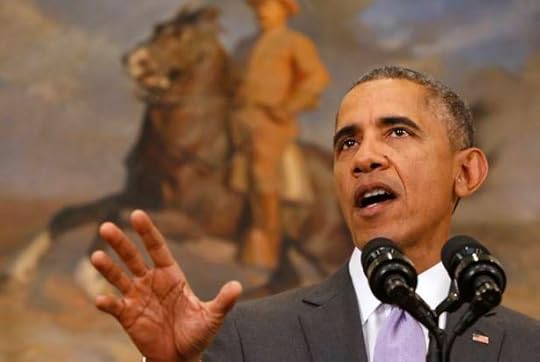
Go about your Thanksgiving business, everyone.
That was the gist of President Obama’s surprise announcement to the American people on Wednesday, which came after a meeting about U.S. security in the wake of the Paris attacks.
“Americans are asking each other whether it is safe here, whether it is safe to fly or gather,” Obama said in a brief statement from the White House’s Roosevelt Room. “And I know that families have discussed their fears about the threat of terrorism around the dinner table, and many for the first time since September 11th, and it is understandable that people worry if something similar could happen here.”
The president said the latest intelligence suggests there is no “specific, credible” threat against the United States. If there is one, he said, “we will let you know.”
“As we are going into Thanksgiving weekend, I want the American people to know that we are taking every possible step to keep our homeland safe,” he said.
The speech was added to the presidential itinerary just over an hour before the president stepped up to the lectern, flanked by Homeland Security Secretary Jeh Johnson, FBI Director James Comey, and Attorney General Loretta Lynch.
After the Paris attacks, which claimed 130 lives, major U.S. cities like New York, Washington, and Los Angeles beefed up their security measures as a precaution. The State Department issued a worldwide alert on Monday for Americans traveling abroad, the third such caution in as many years. The alert did not advise against outright travel, only urging Americans to follow ongoing events and “exercise vigilance when in public places or using transportation.” The department said that “current information” suggests that the Islamic State, al-Qaeda, Boko Haram, and other terrorist groups “continue to plan terrorist attacks in multiple regions.”
The president is taking his own advice. Later Wednesday, he will preside over the White House’s annual presidential turkey pardon, sparing two birds named Honest and Abe from becoming Thanksgiving centerpieces.









The Human Error Behind the Kunduz Hospital Strike

Nearly two months after American strikes killed 30 people at a Doctors Without Borders trauma hospital in Kunduz, Afghanistan, Pentagon officials said that the strikes were the result of “human error.” The admission preempted the release of a military investigation into the episode, which ignited an international firestorm of criticism back in October.
General Joseph Campbell, the top commander in Afghanistan, called the events “a tragic mistake” and said that a number of servicemen involved in the strike had been relieved of duty.
The airstrikes came amid a military response to the Taliban’s recapture of Kunduz, the largest territorial gain for the group since the United States invaded Afghanistan in 2001. In the days following the incident, the American narrative of the events shifted rapidly with officials describing the strikes as “collateral damage,” a response to a threat against American forces, and later, the byproduct of faulty intelligence by the U.S.’s Afghan partners on the ground.
Meanwhile, Afghan officials maintained that the hospital had been harboring Taliban fighters when it was struck. Médecins Sans Frontières, as the group is also known, denied this and maintained that it had sent the GPS coordinates of its facilities to American forces prior to the events.
The Nobel Peace Prize-winning humanitarian group has characterized the episode as a “war crime” and called vigorously for an independent investigation into the airstrikes. While that separate investigation never came, the military report confirmed that the clinic had been mistaken for a Taliban-seized government building.









The #ActualWorst Semi-Final: Fitzgerald Grant vs. Hannibal Lecter
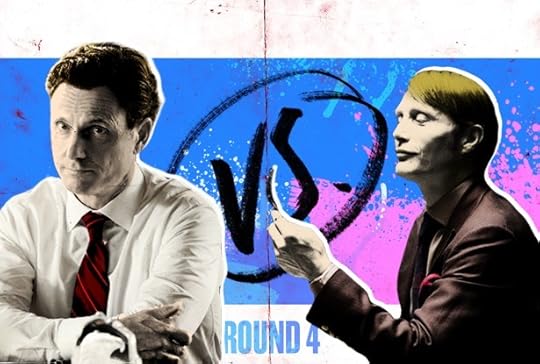
Throughout the month of November, we’re soliciting readers’ help to definitively answer an age-old question: Who is the actual worst character on television? We reviewed your submissions, did our own research, and came up with a list of 32 characters across four different categories, who’ve gone head to head over the last three weeks. Only four are left. Which one of them will be crowned as the most despicable, unlikable, flat-out awful (fictional) person on the small screen?
See the bracket in its entirety here.
David Sims: First things first: Hannibal Lecter and Fitzgerald Grant couldn’t be more different. One’s a psychiatrist who eats people and the other is the President of the United States. Fitz has his foibles, yes, but could you really definitively say he’s worse than someone who once cooked a man’s leg and then fed it to him? But I appreciate the strange symmetry of acting that comes with these two characters. Hannibal is a man of letters, a patron of the arts, and a brilliant dinner guest, but he has to keep his dark side under wraps. Fitz is a politician, and thus his whole public life is a bizarre performance of good and proper behavior.
Still, I’m here to argue for Hannibal, and my argument begins and ends with him eating people. Weirdly, Dr. Lecter might be a more lovable character than his opponent—he certainly kills quite a few villains over Hannibal’s three seasons, while attacking the innocent only when he needs to defend himself or maintain his secrecy. He’s also a gourmet chef and well-read raconteur who helps the FBI catch numerous other serial killers, both before and after they imprison him. But he just can’t shake that compulsion for eating people. How do you top that?
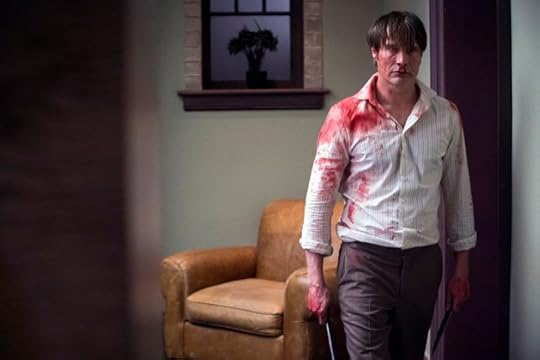 NBC
NBC He’s also a pretty bad psychiatrist—when treating Will Graham, who shows obvious signs of brain inflammation and post-traumatic stress disorder, Hannibal gives him a clean bill of health and practically shoves a gun into his hand, pointing him towards the bad guys. He’s capable of love, but in a rather twisted way, molding a severely damaged trauma survivor in his own image after the death of her serial-killer father, and brainwashing a kidnapped FBI agent so she can serve as an alibi by pinning his crimes on somebody else. Everyone who has a relationship with Hannibal, like his psychiatrist and eventual lover Bedelia (Gillian Anderson), has to be totally in his thrall, or else he abandons them to die.
Also, just one more time for emphasis: He kills people then eats them for dinner. What do you have for me, Matt, that could possibly top Hannibal Lecter’s laundry list of cruelty?
Matt Thompson: What you’ve described is exactly what I like about this matchup, David: There’s a fairly diametrical choice for our voters to make here. Hannibal, from what you’ve described, is all charisma, charm, and jollity, marred by the unfortunate vice of serving his guests to themselves for dinner. Fitz, on the other hand, is an anguished, petulant narcissist with only one comparatively non-repulsive murder to his name.
The sins of President Fitzgerald Grant, though, go far beyond a catalogue of grotesque killings. He brought his nation to war against another—a war he did not believe in and could not justify—to save the life of a woman he wanted to have. Every part of that, from his feckless act of war to his murderous need to get everything he wants, is villainy.
The naked horror on the faces of Fitz’s chief of staff and his cabinet officers when they realized the extent of his psychopathy might not quite match the visceral repulsion you feel at Hannibal’s killings, but Fitz’s deed might be even more gruesome for its bloodlessness. At least Hannibal kills his guests himself. Fitz bloodies the hands of his citizens instead.
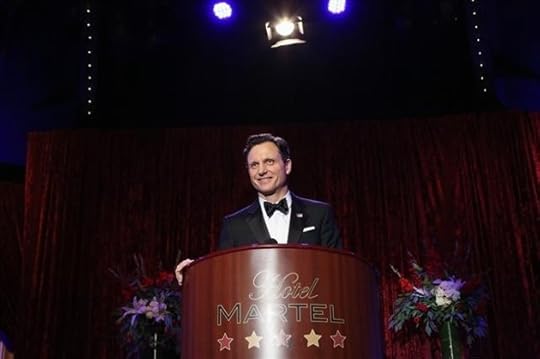 ABC
ABC But much of what we’re measuring here is traits, not deeds. What do these evils reveal about Fitz’s character?
Imagine you’ve gone through your entire life never being told no. Born to wealth, you can have anything you want: a brilliant and beautiful wife who’s made a sort of peace with your brilliant and beautiful mistress; the highest office in the land (whether or not you earned it); power, prestige, good looks, and a house in the country to retire to. Perhaps it’s not your fault that your soul’s corroded into mush. Maybe it’s understandable that you consider the mildest denials to be the depths of human torture. But in the name of Papa Pope and all that is unholy, do you have to be so whiny and possessive even while you’re mansplaining to Olivia what she actually wants?
So let’s tally up the sins of both men: Evil? Check. Murderous? Check. Excruciating? Checkmate, Fitz.
Sims: Perhaps the question before us is one of circumstance rather than psychopathy. What if Hannibal were president of the United States? Would he start cooking foreign dignitaries and serving them at state dinners? He’s certainly happy to abuse the powers of his medical license and psychiatry practice just to delight in the chaos that ensues. I’m not fully up-to-date with Scandal but I’ve watched enough seasons to know Fitz got into office thanks to some tomfoolery with voting machines in Iowa. Hannibal probably wouldn’t have made it that far—as a foreign-born citizen, I doubt he’d be eligible for office—but it’s fun to entertain the concept of him being the most powerful man in the country.
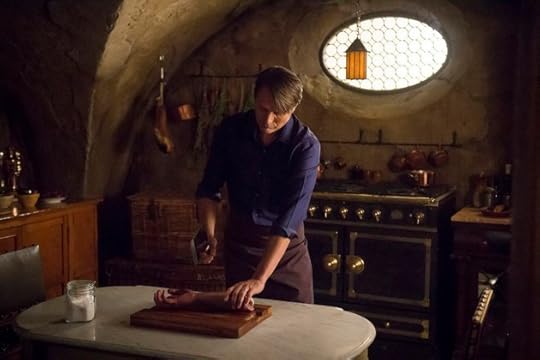 NBC
NBC To stick up for Dr. Lecter, I submit evidence you’ve already referenced—that Fitz commits most of his horrid misdeeds in the name of love, specifically to impress Olivia Pope, or to rescue her, or to entrap her into being with him. Sometimes he strays off the romantic path, like when he held a pillow over a Supreme Court Justice’s face in a hospital bed, but hey, she’d ordered a hit squad on him, right? Hannibal is less of a romantic soul, and the reasons for his murderous tendencies are kept unclear, although it has something to do with trauma he suffered as a child, and the death of his young sister.
So I’m arguing that Hannibal is a purer kind of evil, free of socio-political implications, who literally takes the nightmarish form of a demon stag anytime Will sees him in his dreams. It’s easier to hate Fitz—honestly, I hate Fitz a lot more than Hannibal, but if you’re talking about “actual worst,” there’s nothing actually scarier than a pure psychopath. Also, just one more time: He cooks people and serves their remains to his friends on fancy china! Yes, he never capriciously went to war and cost two countries thousands of lives, but he never had the opportunity. Who knows what Hannibal would do given the circumstances? He’s an enigma wrapped in a mystery—while Fitz, who usually only has one thing on the brain, is deeply, deeply predictable.
Thompson: Ooh, I like the hypothetical! For Fitz’s version of this, I might ask: Is this a case of power corrupting? Would he qualify as evil if he were just an average Joe? We don’t know much about Fitz’s life before he became President, other than that as a Navy pilot, he obeyed an order to shoot down a civilian plane, taking hundreds of lives. That may be a mark of military discipline rather than a lack of moral compass. He rebelled against his father, but his father was a toad, so that tells us little.
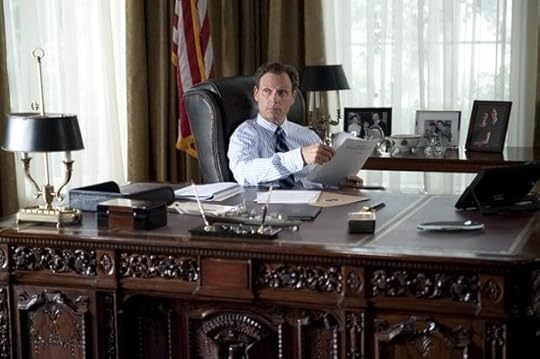 ABC
ABC The only context in which we know Fitz is one in which he’s corrupt and awful despite having nearly everything he wants. Would he be more upright and decent if he had less? What if he wasn’t pretty and moneyed and credentialed enough to snag the likes of Olivia and Mellie? There’s little evidence that these deprivations would have made Fitz more humane, rather than more covetous and entitled. To your observation that he #ActualWorsts out of pure love, is it that Fitz truly loves Olivia, or does she merely represent an object he can’t have? I think he wants her, ardently, but I have exactly zero confidence he’d be a loving and fulfilling partner to her if they ever stopped playing geopolitical footsie. When Fitz grabs Olivia possessively by the elbow, you don’t cringe quite as much as you might because she usually, eventually, grabs him back. But what would he do if she didn’t?
Hannibal the Cannibal is a starker, more gruesome villain than Fitz, I’ll admit. That you still hate Fitz a lot more I think is telling, however. The reason Hannibal’s pure psychopathy induces fear is exactly because it’s so rare and unfamiliar. The reason Fitz’s narcissism and entitlement inspires loathing, I’d argue, is because they’re so recognizable. Hannibal is the stuff of nightmares, yes. But the worst thing about Fitz is that he could be an average Joe, just walking around on the street, meting out recriminations of woefully imaginable scope on everyday, ordinary others. I think that’s a scary enough proposition that Fitz is, in fact, the Actual Worst.









The Fallout From the Downed Russian Warplane
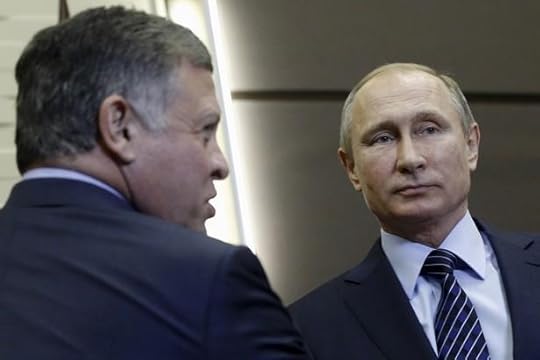
Updated on November 25 at 11:30 a.m. ET
A day after the Turkish military shot down a Russian fighter jet, the two sides traded claims about what happened in the skies over Syria.
Turkish President Recep Tayyip Erdogan said Wednesday that his forces were in their right to fire at the Russian aircraft, which he said had violated the country’s airspace when it approached the border with Syria. Erdogan said there was no Islamic State presence where the Russia military, which has been bombing extremists in Syria, was flying, according to CNN. “Do not deceive us,” he said.
Meanwhile, Russia’s foreign minister Sergei Lavrov said that Turkey’s decision to strike the plane was a “planned provocation,” the Associated Press reported. The pilot who survived the downing said Wednesday that the aircraft did not receive any warnings and was flying inside Syria when it was shot down, the BBC reported. The second pilot was killed by Syrian rebels as he parachuted to the ground.
Hours after the crash, Russian President Vladimir Putin called it “a stab in the back, carried out by the accomplices of terrorists.”
Russian officials have denied claims the jet strayed into Turkish airspace. Turkish officials say they didn't know the plane’s country of origin until Moscow announced it was Russian.
The response from both nations to the incident has been swift. Turkey, a NATO member, called for an emergency meeting of the organization, which urged both sides to avoid a military escalation. Lavrov canceled a trip to Ankara for bilateral talks scheduled for Wednesday, and said Moscow would rethink relations with Ankara. Russia’s defense minister Sergey Shoygu said Wednesday that the country would send defense missile systems to its airbase near Latakia, Syria, just south of Turkey’s Mediterranean coast. Neither country wants to go to war, but the crash further strains relations between Moscow and Ankara in Syria, where Russian forces have bombed Turkish-backed rebel groups fighting against the Assad government. In Russia’s parliament, one lawmaker submitted a bill that criticized those who deny that the killings of Armenians Ottoman Turkish forces in 1915 were a “genocide”—a direct dig at Turkey, which vehemently rejects that description.
In Russia, the AP reported that protesters hurled eggs and stones at the Turkish embassy in Moscow on Wednesday morning, coating the walls and shattering windows.
The Russian warplane, a Sukhoi SU-24, was shot down over Turkey's southernmost tip on Tuesday. The Turkish military said the aircraft ignored 10 warnings to leave. The plane’s two pilots ejected themselves, but came under fire by a Syrian rebel group as they descended. The group told news outlets that both pilots were killed, but on Wednesday, Putin announced that one of the pilots was rescued in a joint, 12-hour operation by Russian and Syrian forces, and is “alive and well” on a Russian base in Syria.
The incident is the first time a Russian or Soviet military aircraft has been shot down by a NATO member since the 1950s.









The Good Dinosaur: Pixar’s First Movie Just for Kids

A conspiracy theory: A huge conglomerate is universally recognized for decades as the best maker of widgets worldwide. Then one day, it’s confronted with a much smaller business that, over the course of several years, proves that it is a better widget-maker still. The huge conglomerate buys the smaller business, but keeps them separate entities. And it puts the chief executive of the latter in charge of widget-making at both firms. Gradually the huge conglomerate’s widgets get better—which makes sense, because the man running widget-making is very good at his job. But at the same time, the widgets produced by the smaller business decline noticeably in quality. What’s going on? Is the chief widget-maker under pressure to devote more energy to the huge conglomerate’s widget-quality than to that of the smaller business?
I have no idea if this is what’s taken place since Disney acquired Pixar in 2006 and put John Lasseter in charge of both animation studios. But it is notable that recent years have seen some of Disney’s best films in a long while—Frozen, Wreck-It Ralph, Big Hero 6—and some of Pixar’s worst: Cars 2, Monsters University, and, now, The Good Dinosaur. (Yes, Inside Out was a lovely exception. But Pixar’s downward slide into sequel-itis since Toy Story 3 has been difficult to miss.)
The Good Dinosaur is by no means a bad movie. But it breaks new ground for Pixar in that it’s the studio’s first feature that is explicitly—and pretty much exclusively—a kid’s movie. The story concerns a fearful, clumsy young apatosaurus named Arlo (voiced by Raymond Ochoa) who gets separated from his family and makes his way back home with the help of a feral caveboy whom he befriends. (Jack Bright snarls and howls wonderfully in the latter role.) Along the way, they encounter creatures both helpful and hostile, and they overcome a variety of obstacles. It’s a simple story, well-told. But it’s also a story about kids, told more or less exclusively from the kids’ perspective.
This is a first for Pixar. Though its previous 15 feature films have often involved children, they’ve been told principally through the perspective of adults (Boo has Sully and Mike; Nemo has Marlin; the Incredibles kids have their parents; and Russell has Carl Fredricksen) or adult-like figures (the toys of Toy Story; the emotions of Inside Out). These grownup interlocutors have given Pixar films an uncommon richness and depth—even those of us outside the immediate target demographic can relate to Marlin’s worry for his son or Carl’s grief over his wife or Woody’s duty to “leave no toy behind.” Stripped of this additional layer, The Good Dinosaur feels less like a Pixar movie and more like … well, a Disney one. (It’s probably worth noting that there were uncharacteristic difficulties during production: The film was originally intended for release two years ago, and the original director, Bob Peterson, was taken off the project midway through.)
Again, though the tale is slender, the execution is strong. The conceit of the film is that it takes place in an alternative world in which the extinction-event asteroid that hit the Earth 66 million years ago instead passed us by harmlessly. The dinosaurs thrived and developed intelligence, language, and a rudimentary culture in which the herbivores became farmers and the carnivores became ranchers. The more recent mammalian arrivals, meanwhile, remain thoroughly undomesticated “critters.” (Arlo’s companion, the quadrupedal dog-boy “Spot,” is one of the chief pleasures of the movie.)
To paraphrase Voltaire: If Monument Valley didn’t exist, Pixar would have had to invent it.A number of Arlo and Spot’s encounters on the long trek home are memorable ones. There’s a styracosaurus—voiced by Peter Sohn, who ultimately directed the film—who keeps a menagerie of animals perched on his horns to protect him from threats both physical (other critters) and emotional (“unrealistic goals”). There’s a flock of pterodactyls (the lead one voiced by Steve Zahn) who are not as they first appear. And there’s a family of T-Rex ranchers who need help with their herd. (The chief joke here, vocal-casting Sam Elliott as a leathery old cowpoke, is perhaps a bit too obvious.)
The visuals are a consistent treat—at least with the exception of Arlo himself, who is rather too much of a cartoon. The rushing river into which Arlo and Spot tumble more than once is a marvel, as are a swarm of igniting green fireflies and a scene in which pterodactyl crests poke down out of the clouds like inverted shark fins. The moment in which Arlo and the pre-verbal Spot try to explain to one another the fates of their respective families hits its emotional notes precisely. And perhaps best of all are the wonderfully detailed and textured landscapes of the Old—as in really, really old—American West. To paraphrase Voltaire: If Monument Valley didn’t exist, Pixar would have had to invent it.
The Good Dinosaur is a better movie overall than recent Pixar misfires such as Cars 2 and Monsters University. But its pronounced lack of ambition is nonetheless a tremendous disappointment. A small herd making its way across the prehistoric plains, pushing through obstacles and learning lessons about themselves in the process? That’s what one expects from The Croods or the Ice Age movies. I, for one, still expect more from Pixar.









The Myth of ‘Easy’ Cooking
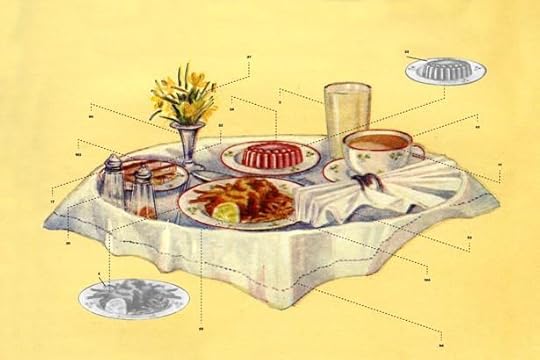
I write about food for a living. Because of this, I spend more time than the average American surrounded by cooking advice and recipes. I’m also a mother, which means more often than not, when I return from work 15 minutes before bedtime, I end up feeding my 1-year-old son squares of peanut-butter toast because there was nothing in the fridge capable of being transformed into a wholesome, homemade toddler meal in a matter of minutes. Every day, when I head to my office after a nourishing breakfast of smashed blueberries or oatmeal I found stuck to the pan, and open a glossy new cookbook, check my RSS feed, or page through a stack of magazines, I’m confronted by an impenetrable wall of unimaginable cooking projects, just sitting there pretending to be totally reasonable meals. Homemade beef barbacoa tacos. Short-rib potpie. “Weekday” French toast. Make-ahead coconut cake. They might as well be skyscraper blueprints, so improbable is the possibility that I will begin making my own nut butters, baking my own sandwich bread, or turning that fall farmer’s market bounty into jars of homemade applesauce.
The disorienting part in all this is that so many of these recipes carry promises of speed and ease. Amazon’s “quick and easy” section is 8,000 titles strong; The New Artisan Bread in Five Minutes a Day is a bestseller. Mark Bittman’s How to Cook Everything empire, launched in 1998, was updated last year with How to Cook Everything Fast. Jamie Oliver published a book of 30-minute meals in 2011, but has more recently shaved the time commitment down to 15. Just yesterday I read about a new cookbook from the editors of Lucky Peach magazine called 101 Easy Asian Recipes, filled no doubt with obscure sauces and vegetables that I have absolutely no hope of finding at the Pioneer supermarket on the corner. Everywhere, there are magazine features proclaiming that making and freezing my own chicken stock is a “no-brainer”; homemade Calabrian chili oil is an “easy” way to add big flavor; the secret to making effortless breakfast granola is to simply do it in big batches.
The problem is that none of this actually easy. Not the one-minute pie dough or the quick kale chips or the idiot-proof Massaman curry, every last ounce of which is made from scratch, from ingredients that are sourced and bought and lugged home and washed, peeled, chopped, mixed, and cooked. Meanwhile, technology has made appetizing, affordable cooking alternatives easier and easier to come by. Food delivery services like Seamless, Munchery, and SpoonRocket carry prepared meals to your home in minutes. Kitchensurfing will send you a personal chef at reasonable cost. The rise of fast casual restaurants from Chipotle to Sweetgreen has made counter-service takeout a dinner option that won’t make you hate yourself in the morning.
All this means that tonight, I can order excellent pad thai from my phone in under a minute. Or, I can find a recipe for “easy” pad thai, run—literally, run—to the grocery store at lunch, hope that grocery store sells fish sauce, then spend 40 minutes making the dish and 20 minutes cleaning up. The decision to cook from scratch may have many virtues, but ease is not one of them. Despite what we’re told, cooking the way so many Americans aspire to do it today is never fast, and rarely easy compared to all the other options available for feeding ourselves.
* * *
It wasn’t always thus. Promises of ease in the kitchen took hold in the 1940s and 50s, thanks to the flood of women entering the workplace, a newly industrialized food supply, and the invention and marketing of a whole range of timesaving kitchen gadgets. Before that, books about cooking largely admitted what every homemaker knew to be true: that feeding people was backbreaking work, and then you died. But suddenly there was GE’s “Care Free Cooking Electrically,” a pamphlet promoting the electric range; Glamour magazine’s After 5 Cookbook for the working woman; Good Housekeeping’s Quick & Easy Cookbook. What separates these from the books we have today is that the recipes are, largely speaking, actually pretty easy. Take, for example, this salad recipe from the After 5 Cookbook: “Break escarole in pieces. Sprinkle with 1 tbs. lemon juice. Serve with mayonnaise.” It’s practically a haiku.
Things shifted in the late 1980s. Food culture emerged. Dean & DeLuca started doing a brisk business in luxury foods, dining out became a sport, and Americans aspired to make much more sophisticated food in their homes. It was the age of pesto, quiche, and imported olive oils, and suddenly recipes calling for “a can of asparagus” or “a box of lime Jell-O” no longer seemed au courant. But the recipes continued to be labeled “quick” and “easy,” and there the problems began.
Take, for example, a panzanella recipe from the “Speedy Salads” section of Anne Willan’s In & Out of the Kitchen In 15 Minutes or Less, a cookbook from 1995. The recipe fills an entire eight-by-10-inch page and requires one to mince garlic, chiffonade basil, de-seed and small-dice a cucumber, small-dice two onions, et cetera. Estimated time commitment: 10 minutes, which is roughly what it would take me to locate all the ingredients in my kitchen (and if 10 minutes is too long, Willan has a from-scratch Chicken in Chili Coconut Sauce that you should have no trouble dashing off in nine. Nine minutes!)
Over the course of the past two decades, as food culture has exploded, recipes like Ms. Willan’s have become commonplace. More of our cookbooks are written by chefs publishing recipes adapted from their restaurants, as opposed to the self-taught home cooks who traditionally authored the lion’s share of the category. Ingredients have gotten more exotic, and less likely to be collected within a trip to your average American grocery store. Za’atar? Yuzu juice? Persian cucumber? For a special cooking project, fine, but galling to discover in the ingredients list for a weeknight dinner.
Real “easy” cooking, if that’s what you’re after, is far too simple to sustain a magazine and cookbook industry.At the same time, magazine test kitchens have shifted from being staffed by seasoned home cooks to young culinary-school graduates, trained in the practices of the professional kitchen (which are entirely based around the premise that a corps of cooks will be working 12 hours a day to create the dishes). Even when these recipes are simplified for home cooking, the fundamental approaches often aren’t practical.
So, why does it matter that recipes marketed as easy often aren’t? A few years ago, I would have interpreted it as a harmless pretense—maybe even a good deed—to nudge people with the lure of simplicity toward cooking for themselves. Now, pulled in a million directions by the demands of a young family, I’m not so sure. Despite the much-ballyhooed increase in men cooking, women still do the lion’s share of the food preparation in this country. And the weight of expectation imposed by our cooking culture, which offers unrealistically complex recipes while at the same time dismissing them as simple, can be crushing.
Food editors are, for the record, acutely aware that their (mostly female) readers want sophisticated meals but feel that the complex recipes offered by chefs are incompatible with their harried lifestyles. So, they make efforts to simplify and streamline, without ever admitting the one thing that cooks really need to hear: that real “easy” cooking, if that’s what you’re after, is far too simple to sustain a magazine and cookbook industry. It relies on foods that can be purchased at a single point of sale and involves a bare minimum of ingredients and a small repertoire of techniques. It leans heavily on things your mom taught you. There are no garnishes of thyme leaves in simple weeknight dinners, and no appetizer salads. Homemade breakfast smoothies are many things, but they are not an “easy” alternative to one of those squeezable yogurt things that you can eat with no hands in the car.
It’s not that the best way to feed yourself is always the fastest one—it almost always isn’t. I love to cook, and wish I still had those wide-open Saturday mornings in which to make wholly unnecessary coffee cakes, or lazy Sunday afternoons for poring through old cookbooks, hunting for new projects. But I think we should talk more realistically about what’s involved in from-scratch cooking, the sacrifices it entails, and the fact that little of the complexity offered by today’s published recipes is really essential to cooking a delicious meal.
Quick cooking rarely comes from a recipe so much as it does from intuition built over the course of hours and hours mucking around in a kitchen. It requires parents to expend some real effort in involving their children in meal preparation, and maybe even home economics curricula returning to schools to teach kids the basics. And whether you’re a parent to young children, a single man or woman with a career in overdrive, or simply an average human deciding what to do with an hour on a Thursday night, if you manage to resist the urge of push-button prepared food and cook a meal for yourself, I tip my hat to you.









November 24, 2015
Darkness in the Arab Spring’s Brightest Spot
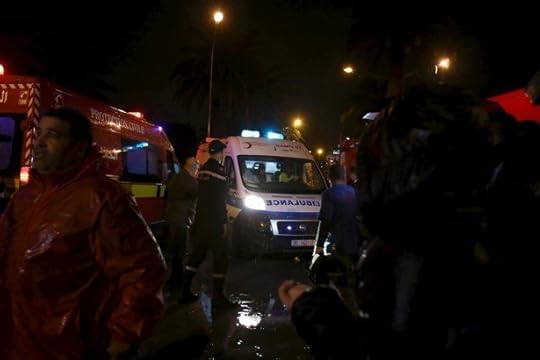
Last month, the Norwegian Nobel Committee bestowed the world’s most prestigious prize upon The Quartet, a body consisting of four Tunisian groups, whose work helped ensure a peaceful democratic transition in Tunisia in 2013.
In its statement, the Nobel Committee paid homage to Tunisia’s successes in the aftermath of the Jasmine Revolution, but also acknowledged that the country still “faces significant political, economic, and security challenges.”
As Tunisia tries to endure as the birthplace of the Arab Spring and its golden child, violence keeps interrupting. Back in March, 23 people died in a terrorist attack at the Bardo Museum in the capital city of Tunis and, in July, 38 tourists were killed when a gunman opened fire at a beach in Sousse. Both attacks were claimed by the Islamic State.
On Tuesday, not far from the Bardo Museum, an explosion killed a dozen Tunisian presidential guards and wounded several others on a bus in the central part of the capital. No group has claimed responsibility yet, but following the attack, President Beji Caid Essebsi reinstated the country’s state of emergency, which had been lifted in October, and set a curfew. The violence comes just one week after Tunisia’s interior ministry boasted that security forces had foiled a major plot against a number of targets when it broke up a heavily armed terrorist cell in the country.
As the Islamic State’s ranks swelled last year, the small North African country also produced the biggest number of foreign fighters in Syria and Iraq. Western analysts still believe that the country’s border towns are a crucial haven for ISIS recruitment.
Tuesday’s attack, especially if claimed by ISIS, doesn’t just undermine Tunisia’s security. It also weakens the model to which other Middle Eastern countries can aspire. Christian Caryl made this case earlier this week for Foreign Policy:
If Tunisia can maintain and expand its democratic institutions, it will send a vital message to the rest of the Middle East and North Africa. It will show that Arabs and democracy don’t have to be mutually exclusive. It will show religious Muslims that they have nothing to fear from the separation of religion and state. And it will show liberals that they don’t have to tolerate corrupt dictators as their only protection against religious dictatorships. A prosperous and vibrant Tunisian democracy is our best counter-argument to jihadist dictatorship.
Following the latest attack, there were still some promising notes. By Tuesday night, Ennahda, the country’s leading Islamist party, issued a statement that called for unity and denounced the assault.
“Tunisia is targeted because it is a democracy and represents a model of moderate Islam,” the party said.









Atlantic Monthly Contributors's Blog
- Atlantic Monthly Contributors's profile
- 1 follower



